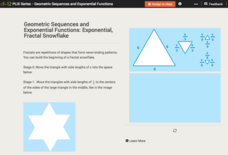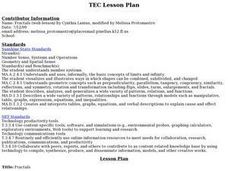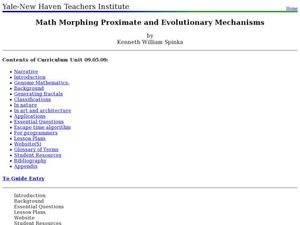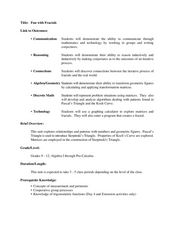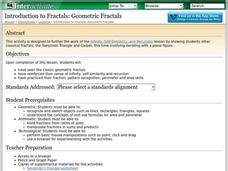Curated OER
Alice in Fractalland
Take your class on a field trip to Fractalland where they'll learn all about number and shape patterns. Based on Disney's movie Alice in Wonderland, this resource takes young mathematicians on an adventure as they explore patterns in...
PBS
Human Tree: Ratios
Create a personal tree. By visiting an exhibit at the National Museum of Mathematics, the resource introduces the idea of fractals. The exhibit takes an image of the person and creates a tree by repeating scaled images on the shoulders...
NOAA
To Explore Strange New Worlds
It's time to boldly go where your class has not gone before! The introductory lesson in a five-part series takes young oceanographers aboard the NOAA Ship Okeanos to begin a study of ocean exploration. The lesson includes a comparison of...
CK-12 Foundation
Exponential Growth: Exponential, Fractal Snowflakes
Examine an exponential growth model. Using a fractal, learners calculate the perimeters of each stage. When comparing the consecutive perimeters, a pattern emerges. They use the pattern to build an equation and make conclusions.
Noyce Foundation
Cut It Out
Explore the mathematics of the paper snowflake! During the five lessons progressing in complexity from K through 12, pupils use spatial geometry to make predictions. Scholars consider a folded piece of paper with shapes cut out....
National Council of Teachers of Mathematics
Math Challenge #23: Fractals
Young scholars explore the concepts of Sierpinski's triangle, ratios, and concentrations. In this exploratory lesson, learners are given three problems to solve. Young scholars learn about Sierpinski's triangle, how to calculate mpg for...
Wake Forest University
Authentic Activities for Connecting Mathematics to the Real World
Check out the handout from a presentation that contains a collection of high school algebra projects connecting a variety of mathematics to the real world. Activities range from simple probabilities to calculus. The activities...
Curated OER
Fabulous Fractals
Students view a video to discover how patterns in nature relate to math. They explore the concept of exponential growth by observing and creating fractals. They solve and design word problems.
Curated OER
Pascal's Triangle
Young scholars explore the concept of Pascal's Triangle. In this Pascal's Triangle activity, students use an applet called 'Coloring Multiples' to explore Pascal's Triangle. Young scholars develop patterns starting with various numbers...
Curated OER
Fractals Teachers' Notes
When you see a flower or a tree in nature do you see the math? This web resource contains many ideas for using fractals in a math class including Sierpinski’s triangle, Koch's Snowflake, and the Jurassic Park Fractal. Additionally, it...
Curated OER
Pyramid in The Desert
Students investigate the Sierpinski triangle and calculate the ratio and area of the triangle. For this fractals lesson, students calculate parts of a Sierpincki triangle. They use Google Earth to help them construct the different parts...
Curated OER
Using Cabri Geometry to Create Fractals
Learners construct the Sierpinski Triangle using Cabri Jr. They use a step-by-step guide to construct the Sierpinski Triangle on their graphing calculator and then discuss the formula for constructing a nth stage Sierpinski Triangle.
Curated OER
Fractals, An Inquiry: Day 3
Students develop questions for their inquiries and plan their experiments. They are supported by a modeled case study of Max the Dog's Inquiry Planning Process, as well as supported by a planning template, The Inquiry Organizer.
Curated OER
Geometric Fractals and the Chaos Game
Young scholars define fractals and patterns. They explore how a seemingly random process can result in a pattern. Students practice probability and fractions skills by playing the chaos game online.
Curated OER
Introduction to Fractals: Infinity, Self-Similarity and Recursion.
This instructional activity introduces students to the ideas involved in understanding fractals. They develop a sense of infinity, self-similarity and recursion and
Curated OER
What are Fractals?
Middle and high schoolers identify and analyze fractals and research information using the Internet to locate information about them. They look at fractals in relation to nature and other real world situations. Pupils create several...
Curated OER
Math Morphing Proximate and Evolutionary Mechanisms
Students identify the different types of fractals. In this geometry lesson plan, students use math to analyze different biological phenomena. They collect data from the experiments and construct graphs.
Curated OER
Fractals Lesson Plan
Students create fractals. In this lesson, students use a computer program to explore different types of fractals.
Curated OER
Fun With Fractals
Pupils use fractals to analyze nature. In this geometry lesson, students work in groups using technology and math to communicate. They identify where in the real world fractal can be seen.
Curated OER
The Sierpinski Triangle
Learners investigate the Sierpinski triangle. In this geometry lesson, students define fractal curves and its relationship to triangles. They identify repeating sequences and relate it to fractals.
Curated OER
The Chaos Game
Pupils measure and predict the behavior of a fractal. In this investigative lesson students divide into groups, and participate in an activity that includes drawing triangles and coloring vertices.
Curated OER
Big Fleas Have Little Fleas!
Learners study seamounts and learn the importance of structures to species. In this ocean explorer lesson, students participate in an activity that teaches them how to modify a seamount so that they are more suitable for species.
Curated OER
Introduction to Fractals: Geometric Fractals
High schoolers explore the concept of fractals. In this fractals activity, students discuss Sierpinski's Triangle using an applet. High schoolers discuss the patterns involved with fractals. Students discuss the area of Sierpinski's...
Curated OER
Fractals and the Chaos Game
Students explore the concept of fractals. In this fractals lesson, students play the "Chaos Game" via an applet. Students place dots on the screen to recognize that they have created Sierpinski's Triangle.





